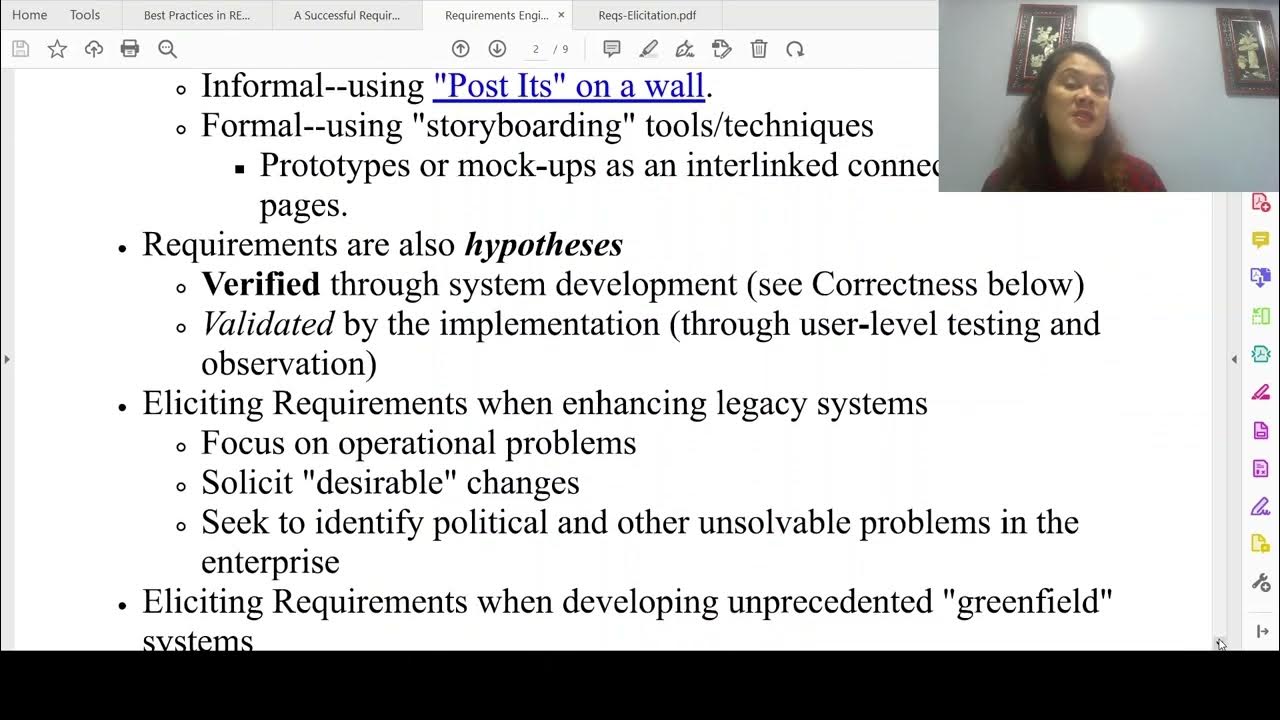Requirement Specification vs User Stories
Summary
TLDRDave Farley 在视频中探讨了软件开发中常见的问题,包括过度依赖手动测试和错误的需求获取。他强调了清晰定义软件需求的重要性,并解释了用户故事与需求之间的关系。Farley 认为,用户故事是一种有效的方法,可以帮助团队从模糊的愿望转变为具体的计算机程序。他建议开发团队应该拥有责任,不仅要关注技术细节,还要理解并引导产品开发的方向。此外,他还讨论了如何正确地使用用户故事来避免技术细节,从而更好地满足用户需求并提高软件开发效率。
Takeaways
- 🔍 软件开发中最常见的问题是过度依赖手动测试和需求定义错误。
- 📝 需求定义错误是软件开发中问题频发的主要原因之一,需要通过有效沟通来明确软件要实现的功能。
- 👥 大多数团队采用敏捷方法,通过用户故事来定义需求,但用户故事与需求并不等同,而是需求定义方式不当。
- 📚 IEEE定义需求为用户解决问题或实现目标所需的条件或能力,这与常见的实施导向的需求描述不符。
- 🛠️ 开发团队不应期望产品所有者或用户能精确定义需求,因为需求本质上是猜测,需要通过开发过程来明确。
- 💡 优秀的开发团队不仅负责技术细节,还应负责产品的开发方向,基于对问题的理解来引导产品发展。
- 🤔 用户或产品所有者通常只知道他们想要的大致方向,而不是具体需求,需求过程的目的是将这些模糊的愿望转化为计算机可执行的描述。
- 📈 将需求过程分为两个独立步骤:明确用户想要什么(需求),以及如何实现(解决方案)。
- 📘 用户故事是有效定义需求的方法,其真正价值在于帮助我们关注用户的目标,而不是系统的具体实现。
- 🏄♂️ 以用户的角度思考,可以发现用户的真实需求和问题,从而设计出更好的软件解决方案。
- 📖 用户故事应该描述用户的目标和系统在不同情况下的行为,而不是具体的用户界面或技术实现。
- 🔑 用户故事的目的是使用户、开发人员和其他利益相关者能够用共同的语言讨论软件的目标和功能。
- 📝 良好的用户故事应该是高层次的,足够精确以捕捉目标,同时足够模糊以允许多种实现方式。
Q & A
软件开发中常见的两个问题是什么?
-软件开发中常见的两个问题是过度依赖手动测试和最初就错误地获取需求。
为什么需求获取会成为一个棘手的问题?
-需求获取成为一个棘手的问题,因为很多团队对需求的理解是错误的,他们将需求视为复杂、以实现为中心的系统描述,而不是用户需要解决的问题或实现目标的条件或能力。
IEEE对需求的定义是什么?
-IEEE定义需求为用户为解决一个问题或实现一个目标所需要的条件或能力。
为什么说许多团队没有真正的需求?
-许多团队没有真正的需求,因为他们没有将需求传达给开发团队,而是提供了实际上是解决方案的高级描述。
开发团队在需求误解中扮演了什么角色?
-开发团队在需求误解中常常是共犯,他们有时会拒绝接受工作,除非需求被更精确地指定,这通常发生在初级团队或官僚组织中。
软件开发的真正任务是什么?
-软件开发的真正任务是将模糊的愿望转化为足够具体的描述,使其能够在计算机上执行。
为什么说用户故事是解决需求问题的有效方式?
-用户故事是解决需求问题的有效方式,因为它们帮助团队专注于用户想要什么,而不是系统如何工作,从而允许团队在找到更好的方法或用户不喜欢早期尝试时尝试不同的解决方案。
如何理解用户故事的真正价值?
-用户故事的真正价值在于它们迫使我们从用户的角度思考,关注用户的目标,并使用用户的语言来捕捉这些目标,从而使非技术团队成员能够更清楚地了解每个故事的含义。
为什么说用户故事应该避免包含技术规格?
-用户故事应该避免包含技术规格,因为它们应该描述用户想要软件做什么,而不是系统如何实现它。这样可以保持故事的通用性和灵活性,允许开发团队选择最合适的解决方案。
如何测试一个用户故事是否写得好?
-要测试一个用户故事是否写得好,可以想象一个完全不同的系统提供相同的客户成果,如果故事仍然有意义,那么它就是一个好故事。
用户故事的目的是是什么?
-用户故事的目的是故意保持高层次,准确捕捉目标,同时足够模糊,以允许多种不同的实现方式。
Outlines

This section is available to paid users only. Please upgrade to access this part.
Upgrade NowMindmap

This section is available to paid users only. Please upgrade to access this part.
Upgrade NowKeywords

This section is available to paid users only. Please upgrade to access this part.
Upgrade NowHighlights

This section is available to paid users only. Please upgrade to access this part.
Upgrade NowTranscripts

This section is available to paid users only. Please upgrade to access this part.
Upgrade Now5.0 / 5 (0 votes)






